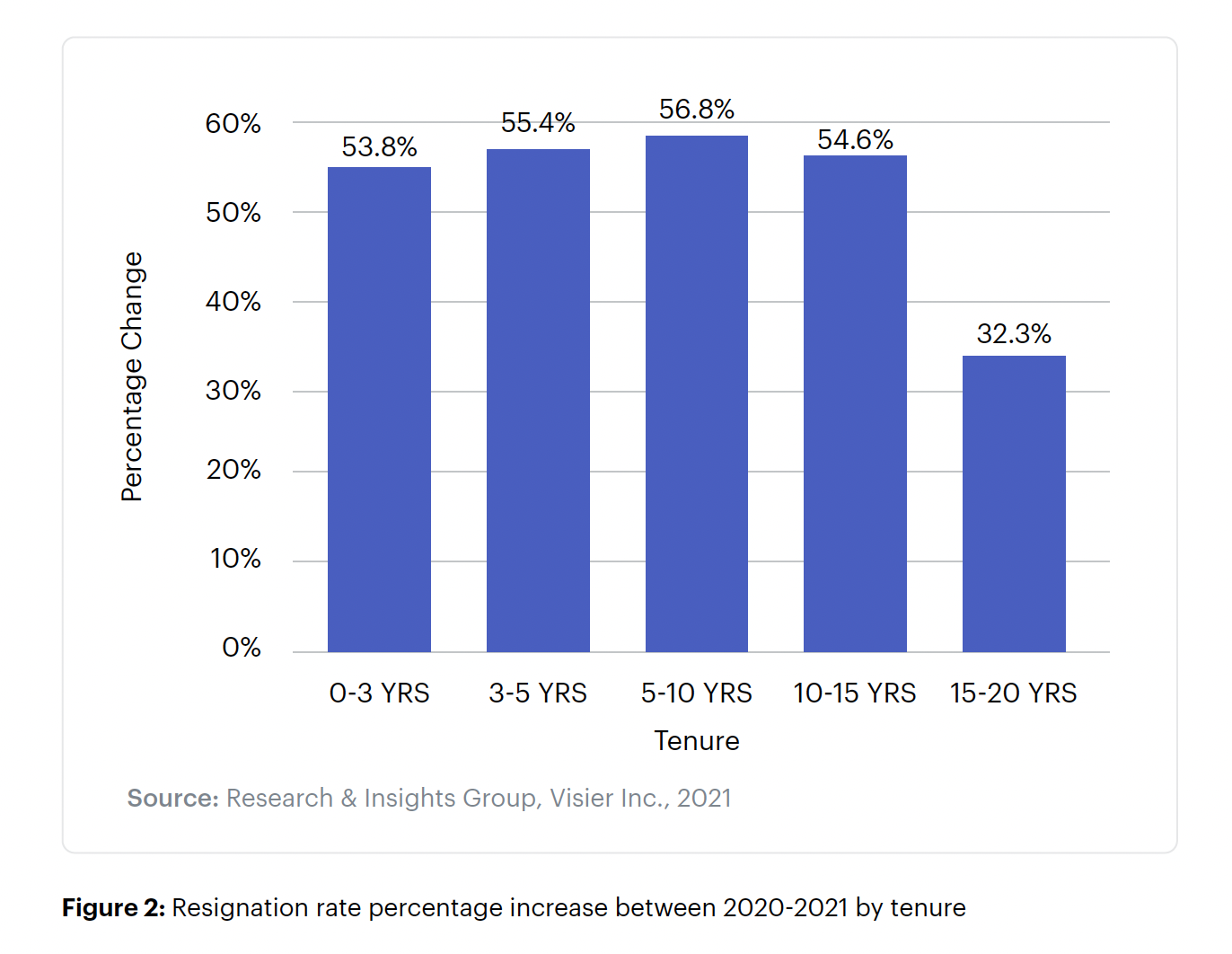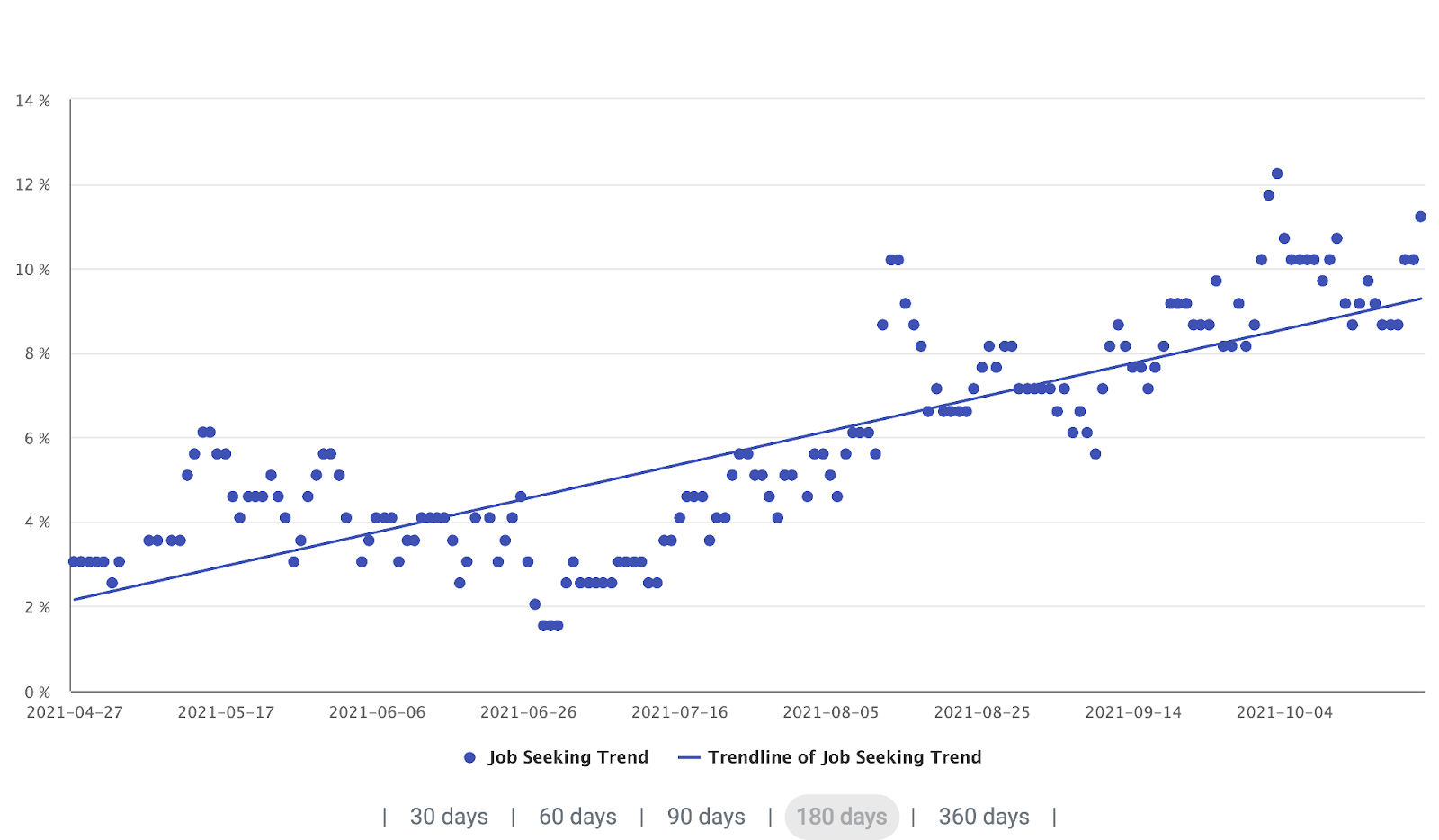By Meredith Metsker
For months, we’ve heard about the “Great Resignation” (or the “Great Reshuffle, if you’re LinkedIn’s CEO). Eye-popping headlines suggest anywhere from 37% to 95% of US workers are considering quitting their jobs this year.
And while those numbers are certainly compelling, they tell an incomplete story for two reasons.
First, many of the percentages cited in news stories related to the “Great Resignation” are based on survey results, some of which stem from absurdly small sample sizes.
For example, a Monster.com survey released in early July said 95% of US workers were considering leaving their jobs. However, the survey only polled 649 workers on June 14. According to the BLS, over 151 million people were employed in the US in June, making Monster’s sample size .00043% of the total US workforce.
Second, these surveys measure intent not action. The results communicate how many people are “considering” leaving their jobs, not how many are currently taking actions to leave. And as anyone who’s ever tried to train for a marathon or quit smoking can tell you, what you say and what you do are two very different things.
This distinction is especially critical for employers (and the HR, talent acquisition, and people analytics teams within those companies) who need to make informed decisions to retain talent in the face of the “Great Resignation.”
Let’s dig into what’s really going on with resignations, why it’s important to measure actions vs. intent, and what all of this means for employers.
People are quitting jobs. Just not 95% of them.
There is no doubt that a massive, unprecedented shift is happening in our economy right now. According to the latest JOLTS report from the Bureau of Labor Statistics, a record 4.3 million people quit their jobs in August. That’s 2.9% of the workforce.
So yes, people are leaving or changing jobs in droves. This is especially true among Gen Z and millennials and within the restaurants/bars/hotels and retail industries. But it’s not just the younger, less-tenured workers that are leaving. According to Visier, employees across all tenures have resigned at record rates in 2021, causing companies to lose some of their most experienced talent.

In addition to those workers who have already quit their jobs, the percentage of workers currently exhibiting passive job seeking behavior has increased by 267% over the last 180 days, according to Claro Analytics, a labor market analytics firm. In this case, “passive job seeking behavior” refers to what people do to polish up their social identity when they start networking for opportunities. This includes business people updating a LinkedIn profile, connecting with recruiters, or getting endorsements or recommendations. For developers, that looks like updating their credentials or certifications, uploading commits to GitHub, etc.

So resignations and passive job seeking behavior are absolutely on the rise, and the “Great Resignation” is far from over. There’s no doubt about that. However, the situation is not as apocalyptic as recent surveys have led us to believe.
Here are a few examples, for context:
- A Monster.com survey (mentioned above), released in July, said 95% of US workers were considering leaving their jobs.
- Joblist released its Q3 US job market report earlier this month, saying “73% of currently-employed workers say that they are actively thinking about quitting their jobs.”
- A Gallup analysis, released in July, found that “48% of America’s working population is actively job searching or watching for opportunities.”
- A report from Microsoft, released in March, said “41% of employees are considering leaving their current employer.”
- A Yahoo Finance/Harris Poll survey, conducted in late June, said more than a third (37%) of US workers are “either thinking of quitting their jobs or are already preparing to make the move.”
These surveys provide interesting insight into the perception around the “Great Resignation,” and tell us what some American workers are thinking about doing. But that’s only half the story, because many surveys’ demographics aren’t transparent. Monster polled 649 people to represent all of the U.S. And even if we agreed that this was an acceptable sample size, certain demographics of workers don’t even have a Monster account, so Monster’s survey would have confirmation bias.
If companies want any chance at responding proactively to this huge labor shift, they need the right data to help them scale the problem and make it solvable.
Intent vs. actions. Why it’s critical to understand the difference.
Speaking of the right data, let’s dig more into the intent vs. actions concept. All of the surveys mentioned above measured intent, namely what respondents said they were thinking, considering, or planning on doing. They didn’t measure the tangible actions they were taking.
To quote American cultural anthropologist Margaret Mead, “What people say, what people do, and what they say they do are entirely different things.”
While it’s important to consider intent data as an indicator of general sentiment among workers, it’s not the end-all be-all. Employers should prioritize action-based data to get a feel for what their employees are actually doing. Are they simply thinking about quitting or are they taking real steps to prepare to quit?
This is what Claro Analytics calls “passive job seeking behavior,” a.k.a. the early indicators that a worker is preparing to take a new job. This is a better indicator of movement in the workforce because it measures the actual actions jobseekers are taking right now, in real-time. Not what they intend to do at some point, someday.
For example, companies use Claro Analytics' Job Seeking Sonar to anonymously measure passive job seeking behavior of their internal workforce. This allows HR and people analytics teams to gather segmented, granular, real-time data that allows them to develop a proactive attrition model to retain their most at-risk employees.
“When you deal with actual identified behavior, the real event and activity-led view of an organization and the people in it, you understand the gap between perception and reality. You can start to form an understanding of reality to build real solutions,” says Ian Cook, Vice President of People Analytics at Visier.
There’s no question that companies are feeling the pressure to retain top talent and fill millions of open jobs. But right now, many organizations are making hasty and possibly irrational decisions based on perception, fear, and intent-based surveys, which only tell a fraction of the story.
Conclusion
As companies navigate the “Great Resignation” and compete to retain and hire top talent, the integrity of their labor data will ultimately determine who wins and who loses. If employers, or we as a society, want to make smart decisions on how to respond to the “Great Resignation,” we need to inform our decisions with real-time, action-based data.
For more information about Claro Analytics or Job Seeking Sonar, visit https://claroanalytics.com/
